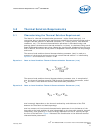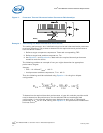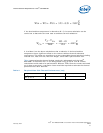
Intel
®
631xESB/632xESB I/O Controller Hub for Embedded Applications
February 2007 TMDG
13
Thermal Solution Requirements—Intel
®
6321ESB ICH
5.0 Thermal Solution Requirements
5.1 Characterizing the Thermal Solution Requirement
The idea of a “thermal characterization parameter” Ψ (the Greek letter psi), is a
convenient way to characterize the performance needed for the thermal solution and to
compare thermal solutions in identical situations (i.e., heating source, local ambient
conditions, etc.). The thermal characterization parameter is calculated using total
package power, whereas actual thermal resistance, θ (theta), is calculated using actual
power dissipated between two points. Measuring actual power dissipated into the heat
sink is difficult, since some of the power is dissipated via heat transfer into the package
and board.
The case-to-local ambient thermal characterization parameter (Ψ
CA
) is used as a
measure of the thermal performance of the overall thermal solution. It is defined by
Equation 1 and measured in units of °C/W.
Equation 1. Case-to-Local Ambient Thermal Characterization Parameter (Ψ
CA
)
The case-to-local ambient thermal characterization parameter, Ψ
CA
, is comprised of
Ψ
CS
, the thermal interface material (TIM) thermal characterization parameter, and of
Ψ
SA
, the sink-to-local ambient thermal characterization parameter:
Equation 2. Case-to-Local Ambient Thermal Characterization Parameter (Ψ
CA
)
Ψ
CS
is strongly dependent on the thermal conductivity and thickness of the TIM
between the heat sink and device package.
Ψ
SA
is a measure of the thermal characterization parameter from the bottom of the
heat sink to the local ambient air. Ψ
SA
is dependent on the heat sink material, thermal
conductivity, and geometry. It is also strongly dependent on the air velocity through
the fins of the heat sink. Figure 5 illustrates the combination of the different thermal
characterization parameters.
Ψ
CA
T
CASE
T
LA
–
TDP
-------------------------
=
Ψ
CA
Ψ
CS
Ψ
SA
+=


















